سواء كنت قد بدأت للتو مشروعًا تجاريًا أو كنت رائد أعمال مخضرم، فأنت تريد أن تسير الأمور بأكبر قدر ممكن من الإنتاجية والكفاءة. ولا يوجد نقص في المنتجات والأدوات والأدوات التي سيحاول الناس بيعها لك لمساعدتك على القيام بذلك. ⚒️
ولكن قبل أن تشتري أداة تعدك بالتخلص بطريقة سحرية من جميع مشاكلك التجارية، تذكر هذا: الأدوات جيدة فقط بقدر جودة الاستراتيجيات والعمليات التي تقف وراءها. 👀
هنا يأتي دور كفاءة العمليات. فهي تساعدك على الكشف عن الأسباب الجذرية لتحديات عملك وتقييم ما إذا كانت التقنيات الجديدة ضرورية حقًا - وإذا كان الأمر كذلك، فأي منها يتوافق بشكل أفضل مع احتياجات فريقك المحددة.
دعونا نلقي نظرة فاحصة على ما هي كفاءة العمليات بالضبط، وسبب أهميتها، وما يمكنك القيام به لتحسينها داخل فرقك.
ما هي كفاءة العمليات؟
كفاءة العمليات تعني تنفيذ المهام بطريقة تحقق النتائج المرجوة مع استخدام الموارد بفعالية وتقليل الهدر. وبعبارة أخرى، الحصول على أكبر قدر من الفائدة لتحقيق أفضل النتائج بأقل قدر من الوقت والجهد والموارد.

## المقاييس الرئيسية لتتبع كفاءة العملية
في هذه المرحلة، من المحتمل أنك تحك رأسك وتفكر: "كيف يمكنني قياس كفاءة العمليات التجارية؟ حسنًا، هناك مقاييس مختلفة يمكنك استخدامها لمعرفة مدى جودة أداء العمليات التجارية.
وتشمل هذه المقاييس وقت الدورة، وكفاءة الموارد، والإنتاجية، ووقت التنفيذ، ومعدل الخطأ، والربحية، والعائد على الاستثمار. يعتمد اختيار المقاييس التي يجب استخدامها على عوامل مثل مجال عملك ونوع العملية وأهداف العمل.

احصل على رؤى حول كفاءة المعالجة باستخدام طريقة عرض عبء العمل ClickUp
ومع ذلك، دعنا نتعمق في ثلاثة مقاييس رئيسية تعتمد عليها معظم الشركات لقياس كفاءة العمليات. 🏊♂️
المكافأة:_ برنامج توثيق العمليات التجارية
زمن الدورة
زمن الدورة هو مقياس لسرعة العملية - المدة التي يستغرقها إكمال عملية تجارية من البداية إلى النهاية.
المعادلة بسيطة: زمن الدورة = إجمالي الوقت / عدد الوحدات (أو الدورات)
لنفترض أنك تريد قياس زمن دورة حل مشكلات العملاء. إذا قمت بحل 100 مشكلة (أو أكملت 100 دورة) في غضون 800 دقيقة، يمكنك حساب وقت الدورة على أنه 800 دقيقة / 100 مشكلة تم حلها = 8 دقائق لكل مشكلة تم حلها.
تعني أزمنة الدورات الأقصر أن العمليات التجارية تسير بسرعة وأن الإنتاجية عالية، بينما تشير أزمنة الدورات الأطول إلى عمليات غير فعالة وإنتاجية أقل.
الإنتاجية
يقيس الإنتاجية القدرة الإنتاجية من خلال النظر إلى عدد المهام التي يمكن إكمالها، أو المنتجات التي يمكن إنتاجها، خلال إطار زمني معين.
وإليك طريقة حسابه: الإنتاجية = إجمالي الناتج / الوقت
على سبيل المثال، إذا كنت تمتلك مصنعًا ينتج 10,000 قطعة شوكولاتة في 10 ساعات، فإن إنتاجية المصنع تساوي 10,000 قطعة شوكولاتة / 10 ساعات، أي 1000 قطعة شوكولاتة في الساعة. عندما يتعلق الأمر بالإنتاجية، فإن الأعلى هو الأفضل!
فالإنتاجية الأعلى تعني أنك تحقق إنتاجية فائقة وتنتج عمليات أكثر كفاءة. من ناحية أخرى، قد يعني انخفاض الإنتاجية أن هناك بعض العوائق أو العمليات غير الفعالة التي تحتاج إلى إصلاح.
معدل الخطأ
معدل الخطأ هو مقياس للدقة والدقة. وهو يقيس التكرار أو النسبة المئوية للأخطاء التي تحدث في عملية أو نظام ما.
إليك المعادلة معدل الخطأ = (عدد الأخطاء / إجمالي المخرجات) × 100%
على سبيل المثال، إذا قامت شركة توصيل بإرسال 1000 طرد في الشهر وتم تسليم 20 منها بشكل خاطئ، فإن معدل الخطأ سيكون (20 / 1000) × 100%، أي 2%.
من خلال الحفاظ على معدل الخطأ منخفضًا، يمكنك تحسين الجودة الإجمالية لمنتجاتك وخدماتك وزيادة رضا العملاء. 🤩
لماذا يعد تحسين كفاءة العمليات أمرًا مهمًا؟
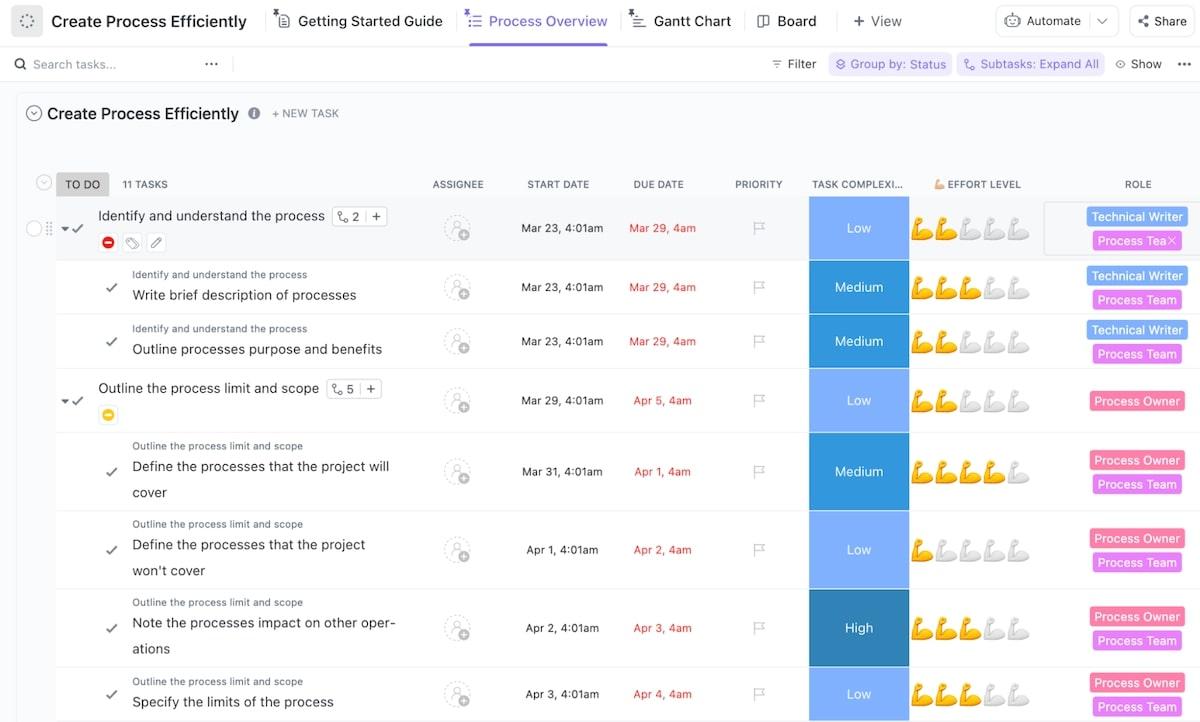
قم بزيادة الإنتاجية وتتبع جميع أنشطة البرنامج باستخدام قالب العمليات الفعالة من ClickUp
قد تكون لديك فكرة بالفعل عن سبب أهمية تحسين العمليات وكفاءة الموارد، ولكن دعنا نتعمق أكثر في سبب أهميتها الحقيقية لعمليات الأعمال.
1. زيادة إنتاجية فريقك بشكل فائق
تعمل الإدارة الفعالة لعمليات الأعمال على التخلص من العوائق والخطوات غير الضرورية، مما يجعل سير العمل أكثر سلاسة. يتيح ذلك لأعضاء الفريق التركيز على المهام المهمة دون إضاعة الوقت أو تشتيت الانتباه.

استخدم وصفات الأتمتة المبنية مسبقًا أو خصصها بناءً على احتياجاتك، حتى يتمكن فريقك من التركيز على ما هو أكثر أهمية
بالإضافة إلى ذلك، بما أن الجميع على دراية بأدوارهم ومسؤولياتهم، فإن الشكوك والارتباك يكون في حده الأدنى. هذا هو المكان الذي يمكن أن يساعد فيه تعيين مديري المشاريع في تحسين التواصل في عملية قائمة أو عملية جديدة.
يتدفق التواصل بسلاسة، وتصبح عمليات التسليم بين أعضاء الفريق سلسة، مما يقلل من التأخير والأخطاء. ✨
2. تحسين جودة عروضك
تخلق كفاءة العمليات أساسًا متينًا للاتساق والتحكم في عملياتك. وهذا يقلل من احتمالية حدوث الأخطاء والعيوب والتكرار غير الضروري. وعندما تحدث الأخطاء، يتم اكتشافها وحلها بسرعة.

كيفية إضافة تبعية إلى علاقة في ClickUp
يضمن لك هذا النهج الاستباقي الحفاظ على سلامة عملياتك وتقديم منتجات وخدمات عالية الجودة باستمرار.
3. تعزيز معدلات رضا العملاء
عندما تلبي منتجاتك وخدماتك باستمرار معايير الجودة العالية، فإن ذلك يؤثر بشكل مباشر على رضا العملاء. يقدّر العملاء المنتجات والخدمات التي تتسم بالموثوقية والاتساق وتتجاوز توقعاتهم.
من خلال تحسين كفاءة العمليات، فإنك تضمن تجربة عملاء متفوقة، مما يؤدي إلى زيادة رضا العملاء وولائهم وإحالات شفهية إيجابية. 🤩
4. بناء سمعة إيجابية للعلامة التجارية
تعكس العمليات الفعّالة التزام علامتك التجارية بالتميز والاستمرارية تحسين العمليات التجارية . يظهر أنك استباقي في إيجاد طرق لتحسين العمليات لتحسين عملياتك وتقديم قيمة للعملاء.
ويساهم ذلك في اكتساب سمعة إيجابية من الاحترافية والموثوقية والجدارة بالثقة التي سيقدرها ويتذكرها عملاؤك وأصحاب المصلحة.
5. زيادة هوامش الربح
عندما تقوم بتبسيط العمليات، فإنك تقوم بتحسين تخصيص الموارد وتقليل التكاليف التشغيلية بشكل كبير. يمكنك أيضًا زيادة مخرجات العملية إلى أقصى حد من خلال زيادة الحجم وتحسين الجودة وإرضاء العملاء.
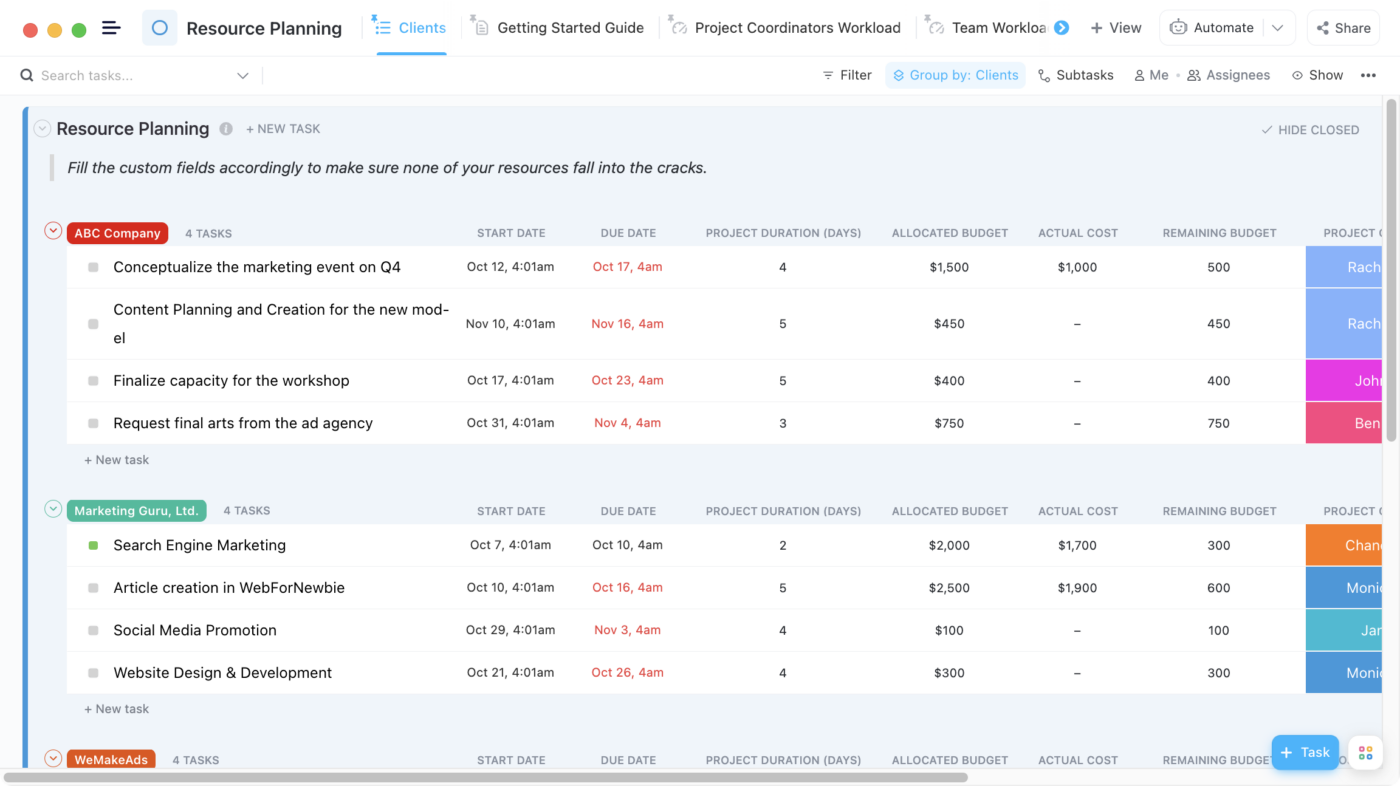
يمكنك إنشاء لمحات عامة لتخصيص الموارد لفريقك بسهولة في طرق عرض قائمة ClickUp للحصول على صورة أفضل للعمل الذي يتم إنجازه
بالإضافة إلى ذلك، عندما يتم تحسين عملياتك، يصبح عملك قادرًا على التعامل مع أحجام أكبر دون تكبد تكاليف إضافية كبيرة. وهذا يفتح لك فرص التوسع في أسواق جديدة، ويعزز قدرتك الإنتاجية، ويتيح لك الاستفادة من وفورات الحجم.
تعمل كل هذه العوامل معًا لتعزيز أرباحك النهائية وزيادة هوامش الربح. 📈
6. تعزيز بيئة الفريق الديناميكية
تحسين كفاءة العمليات التجارية يوضح الأدوار ويعزز التواصل الفعال. يتيح ذلك سرعة اتخاذ القرارات، ويعزز التحسين المستمر ويشجع أعضاء الفريق على المساهمة بأفكارهم واقتراحاتهم.
وكنتيجة للإدارة الديناميكية للعمليات التجارية، يصبح فريقك أكثر إنتاجية ومشاركة وقدرة على التكيف مع التغييرات.
5 خطوات لتحسين كفاءة العمليات فرق العمل
يتكون عملك من عدة عمليات ضرورية لسير العمل بسلاسة. إذا كنت ترغب في تحسين كفاءة العمليات لكل عملية من هذه العمليات، فإليك خمس خطوات بسيطة يجب اتباعها:
الخطوة 1: قم بتخطيط العملية الحالية الخاصة بك
إذا كنت ترغب في تحسين عملية ما، فأنت بحاجة أولاً إلى فهم كيفية عملها. لذا ضع قائمة بكل إجراء في العملية ورتبها بترتيب واضح خطوة بخطوة. يمكنك استخدام تخطيط العملية لتوضيح التدفقات والتفاعلات داخل العملية بأكملها بشكل مرئي.
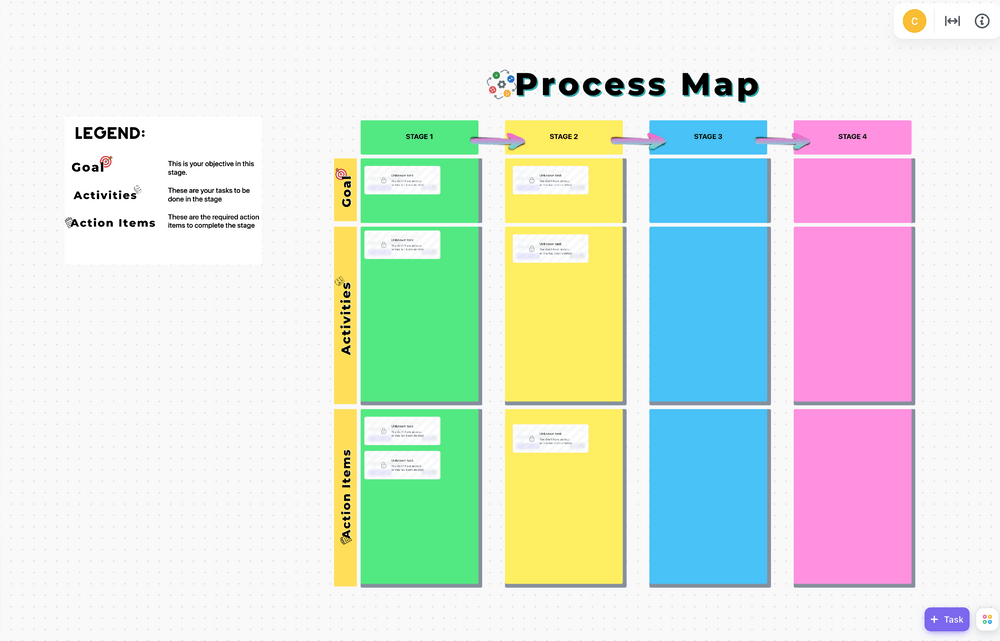
تصور كيف تتدفق المهام في كل مرحلة من مراحل المشروع وتصنيفها إلى أهداف وأنشطة و عناصر العمل باستخدام قالب خريطة العملية هذا المخططات الانسيابية خرائط تدفق القيمة مخططات مسار السباحة ومخططات تدفق العمليات هي بعض الأدوات الشائعة لبناء خرائط العمليات. فهي تجعل من السهل تحديد أوجه القصور أو الاختناقات أو الخطوات غير الضرورية. 🔍
استخدام قالب لوحة بيضاء لخريطة عملية ClickUp لتسليط الضوء على الأنشطة الرئيسية في كل مرحلة من مراحل العملية. يوفر هذا القالب عرضًا واضحًا وشاملًا لسير العمل بأكمله ويمكّن الفرق من العمل بكفاءة وفعالية أكبر.
الخطوة 2: تحديد نقاط القوة والضعف في العملية
مع وجود خريطة العمليات الخاصة بك في متناول اليد، حان الوقت لتحديد المجالات التي يؤدي فيها فريقك أداءً جيدًا، ويحقق الأهداف، ويقدم مخرجات عالية الجودة. ألقِ نظرة فاحصة على هذه المجالات عالية الأداء وفكر في كيفية تحسينها لتحقيق أقصى قدر من الكفاءة. 💪
على الجانب الآخر، ابحث عن مجالات العملية التي لا تعمل بفعالية وما يمكن القيام به حيال ذلك. إليك بعض المشاكل الشائعة التي يجب الانتباه إليها:
- عوائق الاختناقات : حدد أي خطوات في العملية حيث يتأخر العمل أو يتراكم بسبب نقص الموارد أو التبعيات أو عدم كفاءة سير العمل
- التكرار: ابحث عن المهام الزائدة عن الحاجة أو المكررة داخل العملية، والتي تستهلك الوقت والموارد دون إضافة أي قيمة
- ضعف التواصل: حدد المجالات التي ينهار فيها التواصل - سواء كان ذلك بين أعضاء الفريق أو الأقسام - مما يؤدي إلى تأخيرات وأخطاء متكررة في عملية العمل
- المهام اليدوية أو المتكررة: هذه المهام عادةً ما تكون مستهلكة للوقت وعرضة للخطأ البشري. ضع في اعتبارك استخدامأدوات أتمتة العمليات مثل ClickUp لإنجاز المهمة. بهذه الطريقة، يمكن لفريقكتوفير الوقت والتركيز على مهام أكثر أهمية
- عدم كفاية التدريب أو الثغرات في المهارات: حدد المجالات التي يعيق فيها افتقار فريقك للمهارات تنفيذ العملية. قدم التدريب والتطوير في هذه المجالات لبناء مهاراتهم ومعرفتهم وتحسين كفاءة العملية
للكشف عن المزيد من نقاط الضعف وفهمها بشكل أفضل، تحدث إلى أعضاء الفريق الذين يشاركون بشكل مباشر في تنفيذ العملية. قم بإجراء محادثات مفتوحة وصادقة لسماع وجهات نظرهم وتحدياتهم واقتراحاتهم.
الخطوة 3: وضع أهداف ومؤشرات أداء رئيسية واضحة
توفر الأهداف الواضحة إحساسًا بالاتجاه والهدف لكل فرد في فريقك، بينما مؤشرات الأداء الرئيسية المحددة جيدًا (KPIs) تجعل من السهل تتبع التقدم المحرز نحو تحقيق تلك الأهداف.

استخدم ClickUp لتتبع التقدم المحرز باستخدام الأهداف العددية والنقدية والصواب/الخطأ وأهداف المهام
دعنا نحلل الأمر بمثال بسيط:
تخيّل فريق خدمة عملاء يريد تسريع ردوده على استفسارات العملاء. لذلك وضعوا هدفًا واضحًا: تقليل متوسط وقت الاستجابة بنسبة 20% خلال الربع القادم. ولقياس مدى تقدمهم نحو تحقيق الهدف، يختار الفريق مؤشر أداء رئيسي ذي صلة: _متوسط وقت الاستجابة لاستفسارات العملاء
لنفترض أنهم نجحوا في تقليل متوسط وقت المعالجة من 10 دقائق إلى 8 دقائق. سيشير هذا إلى تحسن في كفاءة العمليات التجارية للفريق. وإذا لم ينجحوا في ذلك، فهذه إشارة إلى إعادة تقييم عملياتهم والبحث عن المجالات التي تحتاج إلى معالجة.
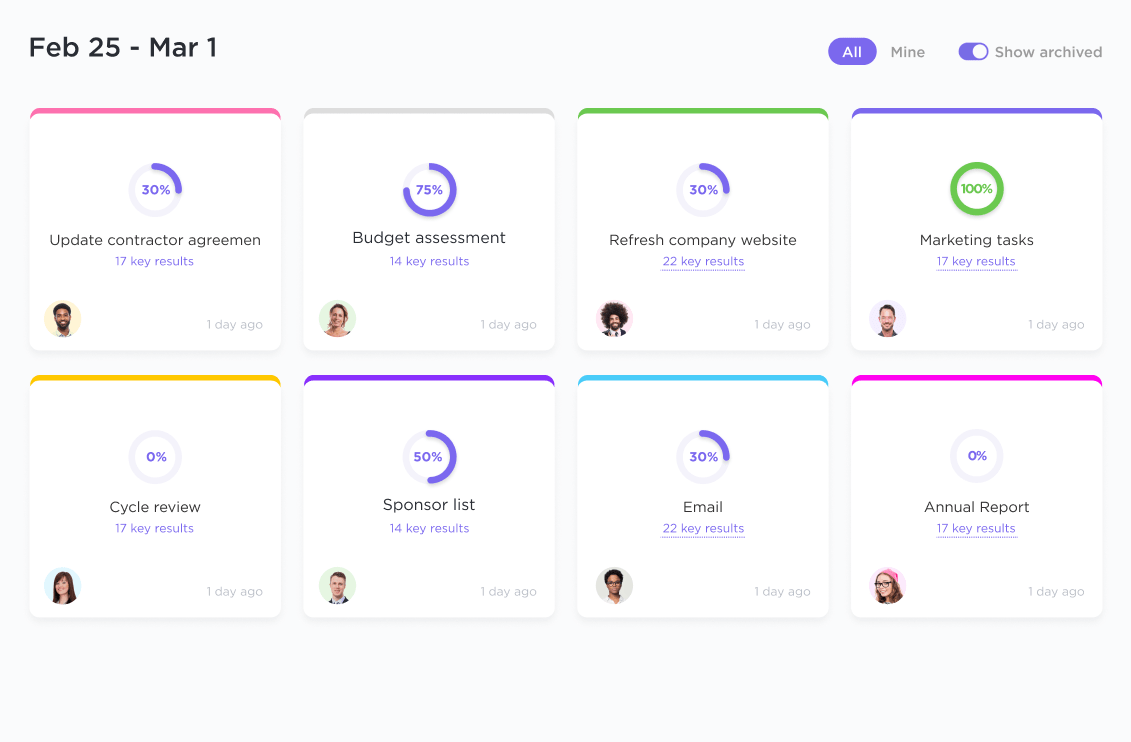
تتبع أهدافك وصولاً إلى مؤشرات الأداء الرئيسية الأكثر أهمية واحصل تلقائيًا على مشاهدات مفصلة عن تقدمك
يؤدي وجود أهداف واضحة ومؤشرات أداء رئيسية قابلة للقياس إلى إنشاء فهم مشترك لما يجب تحقيقه وكيفية قياس التقدم المحرز. ونتيجة لذلك، يمكن لفريقك التركيز على المهام المهمة بالفعل وتقديم نتائج عالية الجودة باستمرار. 🙌
الخطوة 4: إعادة تصميم وتحسين العملية
إن مفتاح إعادة الهيكلة والتحسين الفعال هو وجود أهداف واضحة ومؤشرات أداء رئيسية وفهم شامل لنقاط ضعف عملية الأعمال الحالية. يساعدك ذلك على التركيز على المجالات الحرجة و تحديد أولويات جهودك حتى تتمكن من تحقيق أهدافك.
فيما يلي بعض المجالات الرئيسية التي يجب مراعاتها أثناء عملك على بناء عمليات تجارية أكثر كفاءة:
- تحسينإدارة سير العمل: إعادة تنظيم العملية الحالية أو الجديدة وتبسيطها، وإزالة الخطوات غير الضرورية، والبحث عن فرص لأتمتة المهام اليدوية أو المتكررة باستخدام أداة أتمتة العمليات
- تحسين تخصيص الموارد: تقييم وإعادة توزيع الموارد داخل العملية، بما في ذلك الموظفين والوقت والمعدات. تأكد من تعيين الأشخاص المناسبين للمهام المناسبة وتجنب إثقال كاهل أعضاء الفريق أو ترك المهام دون تخصيصها
- توفير الموارد الكافية: بناءميثاق الفريقوخرائط عملية مفصلة، وإجراءات التشغيل القياسية (SOPs) للتأكد من أن فريقك لديه فهم واضح لما يجب القيام به. بالإضافة إلى ذلك، قدم دورات تدريبية وتأهيلية لمعالجة أي ثغرات في المهارات
- اجمع التعليقات: شارك التغييرات المقترحة مع أعضاء فريقك لإشراكهم في العملية، وطرح الأفكار والحصول على ملاحظاتهم. شجّعهم على طرح الأسئلة ومشاركة المخاوف وتقديم الاقتراحات - ثم خذ مدخلاتهم في الاعتبار وقم بإجراء أي تعديلات مطلوبة

إنشاء نماذج أكثر ذكاءً في ClickUp باستخدام المنطق الشرطي لتبسيط العملية - بغض النظر عن مدى تعقيدها
يمكّن المنطق الشرطي من إنشاء نموذج واحد قابل للتكيف يلبي العديد من السيناريوهات، مما يوفر وقتًا حاسمًا لكل من القائم على ملء النموذج ولك!
من خلال استخدام المنطق الشرطي في النماذج، لديك القدرة على:
- صياغة النماذج التي يتم تعديلها بشكل فوري بناءً على اختيارات الحقول السابقة، مما يستوعب مجموعة واسعة من حالات الاستخدام
- تبسيط إكمال النموذج من خلال عرض الحقول ذات الصلة باحتياجات المستخدم فقط
- التعامل مع الإجراءات المعقدة من خلال جمع بيانات أكثر دقة من المستجيبين، والتي يمكن أن تنشط عمليات سير عمل أو أتمتة محددة
الخطوة 5: تنفيذ العملية وتتبعها وتحسينها
بعد توخي الحذر التخطيط وتحديد الأولويات حان الوقت لوضع العملية الجديدة موضع التنفيذ. خلال هذه المرحلة، يعد التواصل والتعاون الفعال أمرًا ضروريًا.
أوصل العمليات المحسّنة بوضوح إلى فريقك حتى يفهموا الأسباب الكامنة وراء التغييرات والنتائج المتوقعة. قم بتعيين أدوار ومسؤوليات محددة لكل عضو من أعضاء الفريق، مع التأكد من فهم الجميع لمهامهم وكيفية مساهمتهم في كفاءة سير العمل.
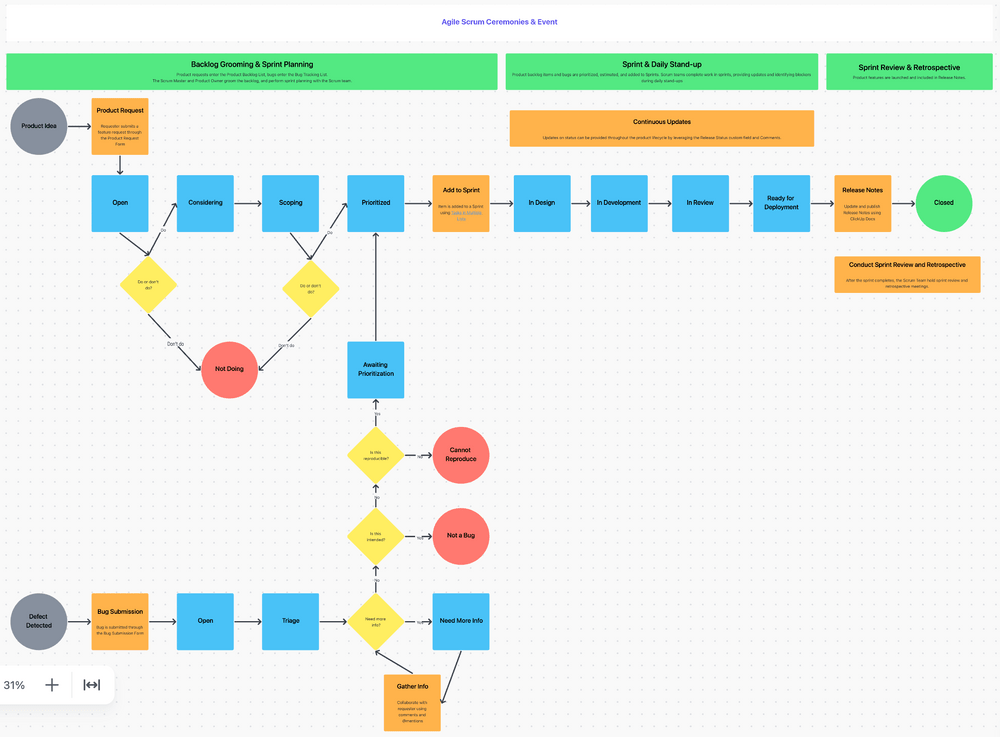
استخدم طريقة عرض السبورة من أجل خطة المشروع وتحسين سير العمل في العمليات الرشيقة للحصول على رؤية أكثر شفافية
بمجرد وضع العملية في مكانها الصحيح، عليك تتبع تقدمها للتأكد من أنها تعمل على النحو المنشود. ستوفر مراقبة مؤشرات الأداء الرئيسية وقياسها رؤى قيمة، لذا قم بتنفيذ نظام لجمع البيانات وإعداد التقارير بانتظام.
يمكن أن يكون ذلك من خلال إدارة المشروع الأدوات أو جداول البيانات أو البرامج المتخصصة. شجع أعضاء الفريق على تقديم تحديثات ومشاركة ملاحظاتهم.
مراجعة البيانات المجمعة بانتظام وتحليل النتائج. هذه الخطوة حيوية في تحديد المجالات التي تتفوق فيها العمليات والمجالات التي تتطلب المزيد من التحسين. استخدم هذه الأفكار لاتخاذ قرارات مستنيرة واتخاذ الإجراءات التصحيحية اللازمة.
تذكر أن تحسين العمليات هو جهد مستمر يهدف إلى تحسين الكفاءة باستمرار.
رفع مستوى كفاءة العمليات في فريقك لتحقيق أهداف عملك
باتباع الخطوات التي أوجزناها، ستتمكن من تحسين جودة منتجاتك وخدماتك بشكل كبير، وستتخلص من الممارسات المهدرة، وستحقق أهداف عملك في نهاية المطاف.
وإذا كنت ترغب في تبسيط عملياتك الفعالة والوصول إلى أهدافك بشكل أسرع، فإن أتمتة سير العمل يمكن لأداة مثل ClickUp أن تغير قواعد اللعبة في تحسين كفاءة سير العمل عبر جميع فرق العمل في شركتك. 💼
باستخدام ClickUp، يمكنك عمل تحديد الهدف بسهولة، وتحسين تدفق الاتصالات، والتعاون في الوقت الفعلي، وأتمتة المهام المتكررة، و إنشاء التقارير -في مكان واحد
يمكنك أيضًا الاستفادة من قالب العمليات والإجراءات الخاص ب ClickUp والذي عندما يقترن بفعالية استراتيجيات إدارة عمليات الأعمال (BPM) ، هي أدوات قيمة للمساعدة في مبادرة العمليات الفعالة الخاصة بك.
الآن يمكن لفريقك التركيز على الأنشطة ذات القيمة المضافة التي تدفع أعمالك إلى الأمام. وإليك أفضل الأخبار: يمكنك ابدأ باستخدام ClickUp على الخطة المجانية للأبد!

